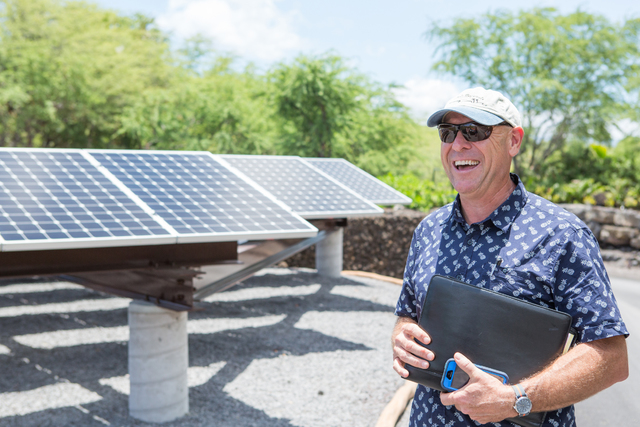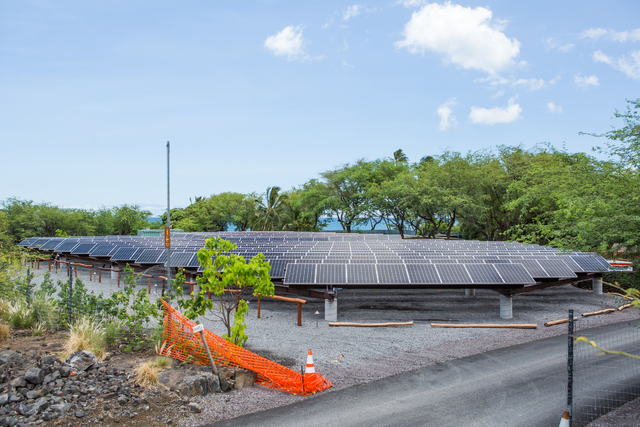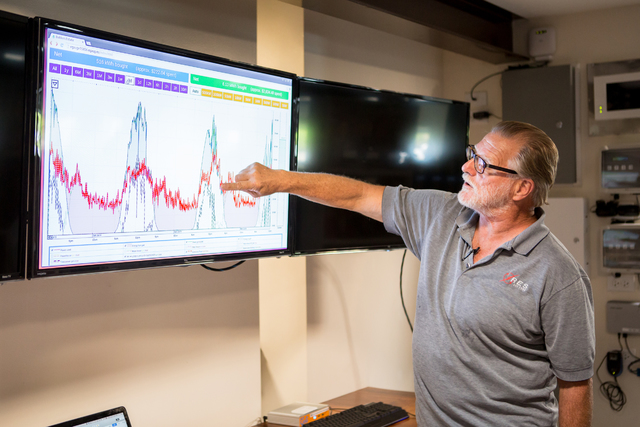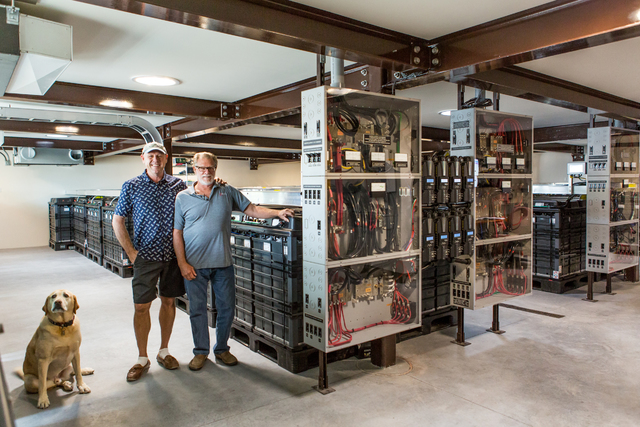A pristine stretch of the North Kona coast has become home to what is likely the largest residential micro-grid project of its kind in the world.
The 512-panel array at the Bakken Estate at Kiholo Bay is generating more than enough electricity to fuel the residence while reducing its carbon footprint to almost nothing and saving its owner thousands of dollars each month off the would-be utility bill.
Energy from the 177-kilowatt array flows into a 2,500-square-foot air-conditioned control and battery room that could be likened to a bunker, where massive banks of the latest in environmentally-friendly batteries store the juice in a 1 megawatt-hour system.
The solar installation is intended not only to showpiece the power of a micro-grid in reducing fossil fuel dependency; it’s also meant to eliminate exhaust fumes and noise. The system replaces three 150-kilowatt propane generators that have chugged away at the 10-acre estate for 23 years.
“It’s easy to feel good about what we’ve done here. We’ve reduced CO2 emissions equivalent to taking 60 cars off the road every day,” said Earl Bakken, the founder of the medical technology giant Medtronic and developer of the pacemaker.
When the 2011 tsunami swept the Kona coast, 4- to 6-foot waves rolled over the terrain where the array and control room are built. Bakken and those planning the micro-grid took those lessons into account, said Adam Atwood, lead coordinator for the Bakken Hale. Protecting the battery room are 9-inch-thick concrete walls that can take the force of a 4-foot breaking wave.
The good news about the technology housed there, though, is that toxic pollution would not occur even if the batteries were washed into the ocean.
That’s because the power storage ingredients are essentially a combination of saline solution, cotton and carbon — a major reason that technology was selected, Atwood said. It’s also part of the reason the project couldn’t be realized until recent advancements made the Aqueous Hybrid Ion batteries available.
“We were looking at lead acid batteries, but they’re toxic and don’t last long,” Atwood said. “And we didn’t want to use lithium ion batteries in this pristine conservation area.”
Atwood and his design team toured the factory of Aquion Energy Inc. in Pittsburgh before deciding the batteries — which are about 4-foot square and weigh 3,300 pounds each — were right for their project. The batteries have a 20-year lifespan with little maintenance, and the technology is comparable in cost to premium lead acid batteries.
“The batteries don’t get hot, they don’t produce gas and there are no toxic elements,” Atwood said.
He and Bakken had 44 of them installed, designed to give the estate a three-day buffer against periods of cloudiness. A biodiesel generator offers backup power in rares cases of prolonged cloudiness.
With a tastefully configured control room decked out with big-screen computers that seem space-age, the project looks expensive. While Atwood declines to name the specific cost, he does say the setup pays for itself in 6 1/2 years.
It’ll meet all of the estate’s energy needs into the foreseeable future by generating power that would cost $7,000 to $8,000 a month to buy from Hawaii Electric light Co., estimates Peter Shackelford, president of Renewable Energy Services Inc., the Hawaii Island company that installed the system.
The system of battery monitors and inverters communicates back to the factory in Pittsburgh via the Internet — and to Shackelford’s smart phone. He is then able to update the system remotely and make sure the load is being supplied.
Piecing together the different parts of the system and getting them communicating with each other was the most challenging aspect, Atwood said, and it made this particular setup unique in the world.
“It’s the future of all battery systems,” Shackelford said. “The battery has to be smarter. The homeowner no longer has to be responsible for monitoring.”
The project is scaleable, meaning that simpler and smaller versions suitable for a normal residence are readily available, said Shackelford.
Residential micro-grids with battery storage start around $40,000, and there are a half dozen such homes that Shackelford knows about on the island. With state and federal tax credits in place designed to encourage solar, the projects pay for themselves in six to seven years, he said.
“The Big Island has so much land that is not served by HELCO,” Shackelford said. “There has always been a huge off-grid presence on this island.”
Email Bret Yager at byager@westhawaiitoday.com.













